Selective repression of RET proto-oncogene in medullary thyroid carcinoma by a natural alkaloid berberine
- PMID: 26307103
- PMCID: PMC4549123
- DOI: 10.1186/s12885-015-1610-5
Selective repression of RET proto-oncogene in medullary thyroid carcinoma by a natural alkaloid berberine
Abstract
Background: The gain-of-function mutation of the RET proto-oncogene, which encodes a receptor tyrosine kinase, is strongly associated with the development of several medullary thyroid carcinomas (MTCs). Thus, the RET protein has been explored as an excellent target for progressive and advanced MTC. In this study we have demonstrated a therapeutic strategy for MTC by suppressing the transcription of RET proto-oncogene though the stabilization of G-quadruplex structure formed on the promoter region of this gene using a natural product berberine.
Methods: Medullary thyroid carcinoma (MTC) TT cell line has been used to evaluate the effects of berberine on RET expression and its downstream signaling pathways. The specificity of berberine was demonstrated by using the papillary thyroid carcinoma TPC1 cell line, which lacks the G-quadruplex forming sequence on the RET promoter region due to chromosomal rearrangement.
Results: Berberine suppressed the RET expression by more than 90 % in MTC TT cells at a concentration of 2.5 μg/ml with minimal effect on the TPC1 cells. Canadine, which is a structural analogue of berberine, showed little interaction with RET G-quadruplex and also had no effect on RET expression in MTC TT cells. The down-regulation of RET with berberine further inhibited the cell proliferation through cell cycle arrest and activation of apoptosis in TT cells, which was confirmed by a 2-fold increase in the caspase-3 activity and the down-regulation of cell-cycle regulatory proteins.
Conclusion: Our data strongly suggest that the G-quadruplex forming region and the stabilization of this structure play a critical role in mediating the repressive effect of berberine on RET transcription.
Figures
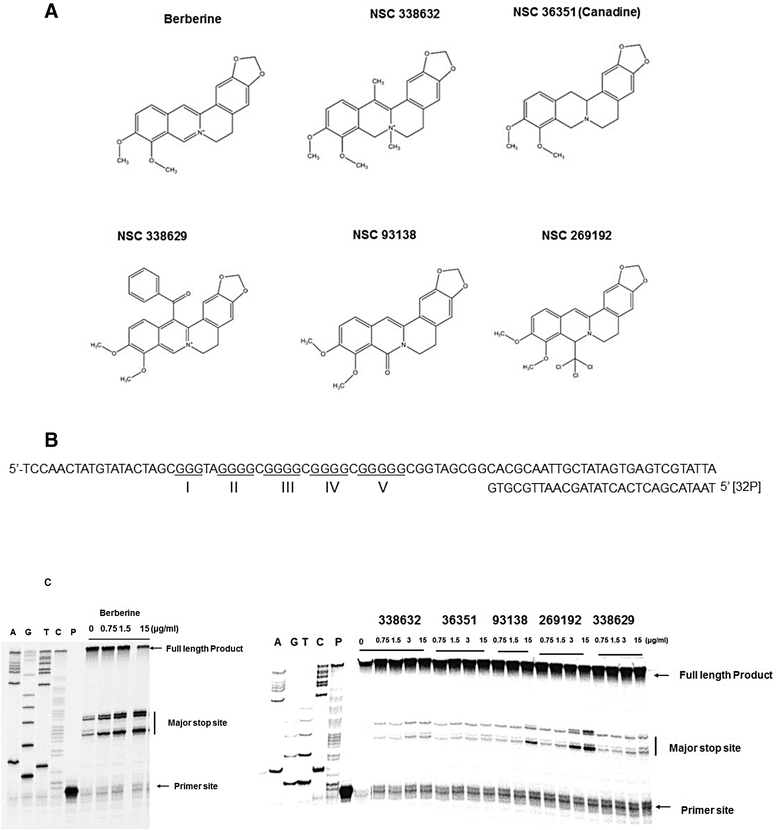
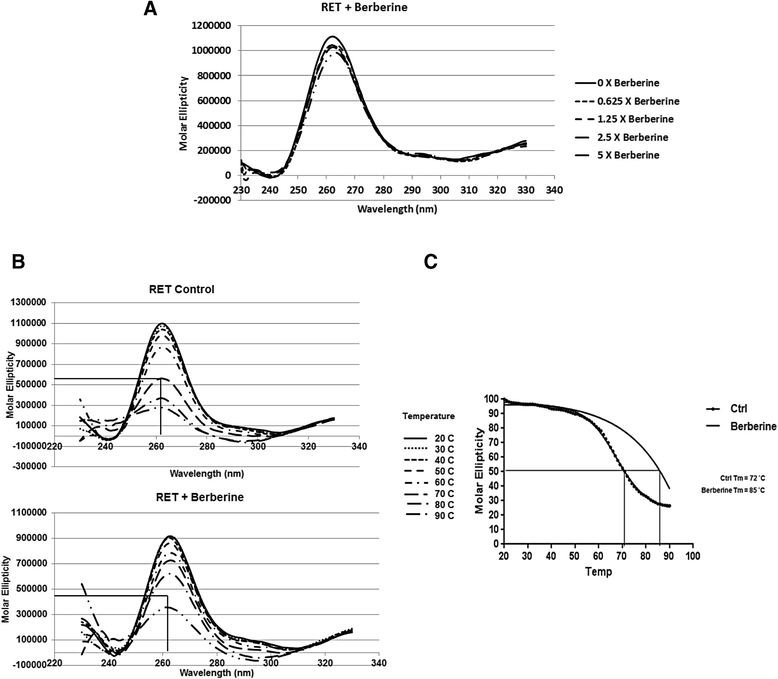

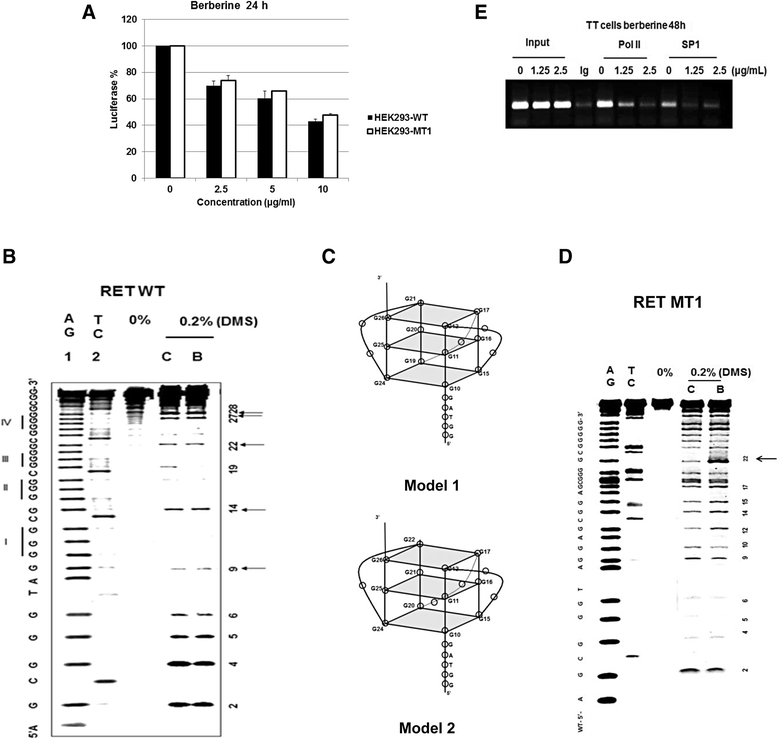
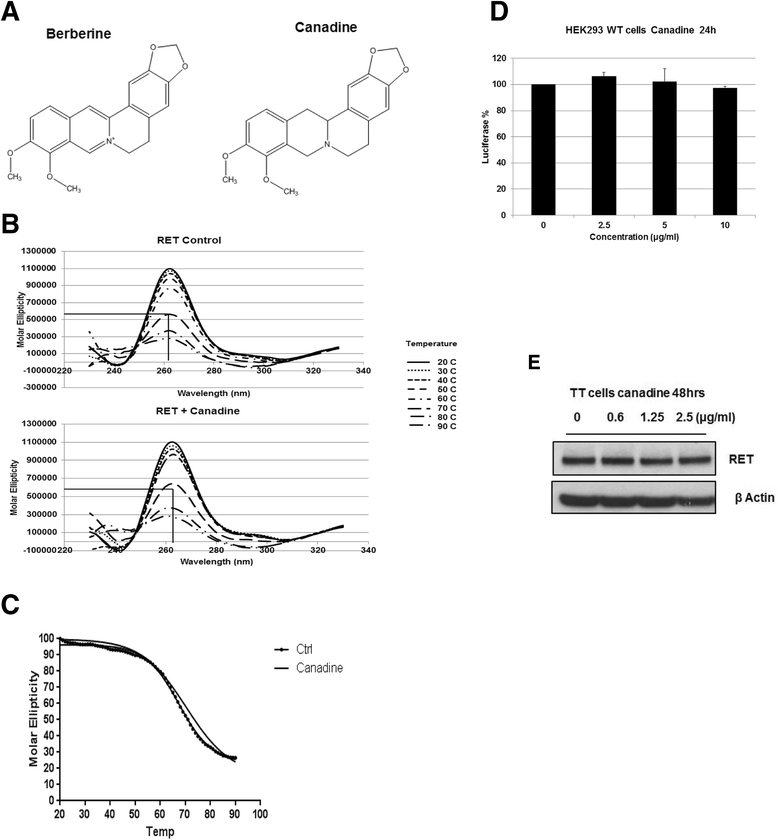
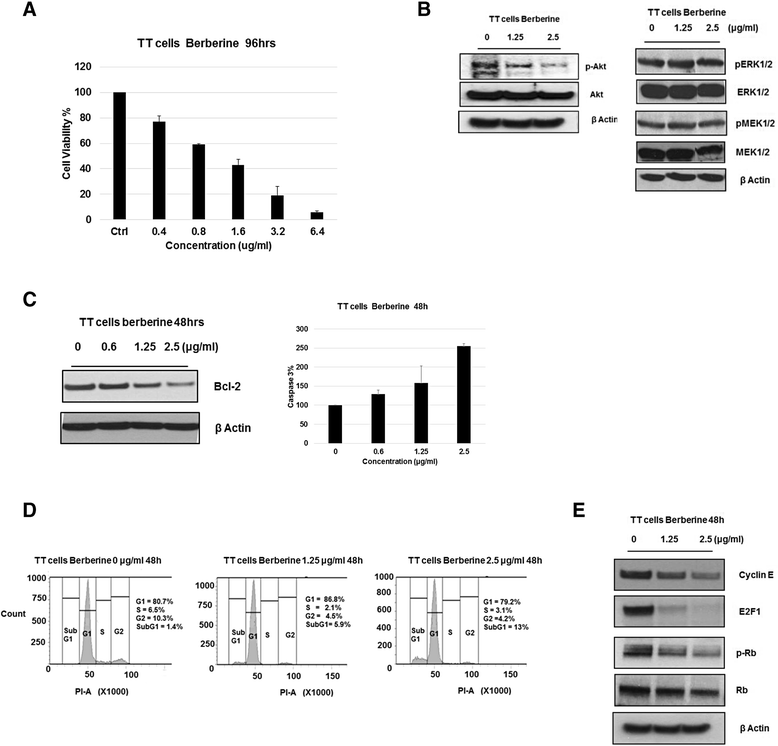
Similar articles
-
Demonstration of a potent RET transcriptional inhibitor for the treatment of medullary thyroid carcinoma based on an ellipticine derivative.Int J Oncol. 2017 Jul;51(1):145-157. doi: 10.3892/ijo.2017.3994. Epub 2017 May 11. Int J Oncol. 2017. PMID: 28498409 Free PMC article.
-
Targeting of RET oncogene by naphthalene diimide-mediated gene promoter G-quadruplex stabilization exerts anti-tumor activity in oncogene-addicted human medullary thyroid cancer.Oncotarget. 2016 Aug 2;7(31):49649-49663. doi: 10.18632/oncotarget.10105. Oncotarget. 2016. PMID: 27351133 Free PMC article.
-
Involvement of G-quadruplex structures in regulation of human RET gene expression by small molecules in human medullary thyroid carcinoma TT cells.Oncogene. 2015 Mar 5;34(10):1292-9. doi: 10.1038/onc.2014.65. Epub 2014 Mar 24. Oncogene. 2015. PMID: 24662821
-
Diversity of mutations in the RET proto-oncogene and its oncogenic mechanism in medullary thyroid cancer.Crit Rev Clin Lab Sci. 2016 Aug;53(4):217-27. doi: 10.3109/10408363.2015.1129529. Epub 2016 Jan 27. Crit Rev Clin Lab Sci. 2016. PMID: 26678667 Review.
-
Use of Tyrosine Kinase Inhibitors for Treatment of Medullary Thyroid Carcinoma.Recent Results Cancer Res. 2015;204:227-49. doi: 10.1007/978-3-319-22542-5_11. Recent Results Cancer Res. 2015. PMID: 26494392 Review.
Cited by
-
The Management of Medullary Thyroid Carcinoma in the Era of Targeted Therapy.Eur Endocrinol. 2016 Mar;12(1):39-43. doi: 10.17925/EE.2016.12.01.39. Epub 2016 Mar 15. Eur Endocrinol. 2016. PMID: 29632588 Free PMC article. Review.
-
G-quadruplex DNA: a novel target for drug design.Cell Mol Life Sci. 2021 Oct;78(19-20):6557-6583. doi: 10.1007/s00018-021-03921-8. Epub 2021 Aug 30. Cell Mol Life Sci. 2021. PMID: 34459951 Free PMC article. Review.
-
Canadine inhibits epithelial mesenchymal transformation of HPV-negative cervical cancer.Tissue Barriers. 2024 Jul 2;12(3):2256641. doi: 10.1080/21688370.2023.2256641. Epub 2023 Oct 11. Tissue Barriers. 2024. PMID: 37819188 Free PMC article.
-
Ligand binding to telomeric G-quadruplex DNA investigated by funnel-metadynamics simulations.Proc Natl Acad Sci U S A. 2017 Mar 14;114(11):E2136-E2145. doi: 10.1073/pnas.1612627114. Epub 2017 Feb 23. Proc Natl Acad Sci U S A. 2017. PMID: 28232513 Free PMC article.
-
Demonstration of a potent RET transcriptional inhibitor for the treatment of medullary thyroid carcinoma based on an ellipticine derivative.Int J Oncol. 2017 Jul;51(1):145-157. doi: 10.3892/ijo.2017.3994. Epub 2017 May 11. Int J Oncol. 2017. PMID: 28498409 Free PMC article.
References
-
- Chen Z, Qi X, Fei J, Yu X, Zhao Y, Zhao J, Jin H, Wang J, Ying R, Zhang X. Multiple endocrine neoplasia type 2A caused by a p.C618R RET proto-oncogene mutation in a Chinese pedigree. Zhonghua Yi Xue Yi Chuan Xue Za Zhi. 2014;31(3):348–351. - PubMed
-
- Carter MT, Yome JL, Marcil MN, Martin CA, Vanhorne JB, Mulligan LM. Conservation of RET proto-oncogene splicing variants and implications for RET isoform function. Cytogenet Cell Genet. 2001;95(3–4):169–176. - PubMed
Publication types
MeSH terms
Substances
Supplementary concepts
LinkOut - more resources
Full Text Sources
Other Literature Sources
Medical
Research Materials

